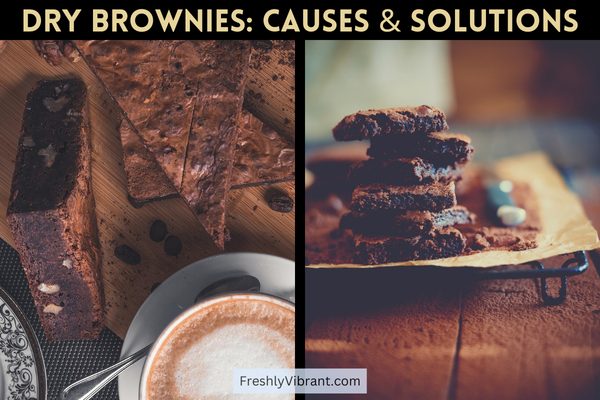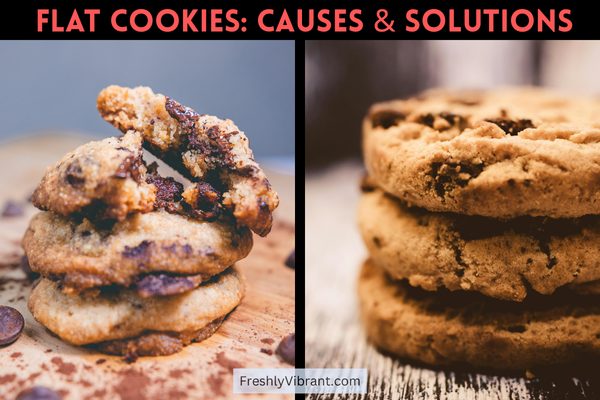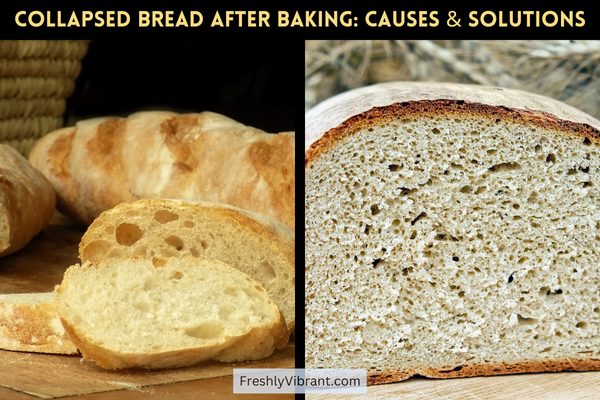Why Are My Cookies Hard After Cooling? (How to Keep Them Chewy)
You pull them out of the oven—golden, beautiful, and smelling like sweet, buttery dreams. But fast forward 30 minutes, and suddenly… CRUNCH. What happened?! If your cookies are going from chewy perfection to brick status, you’re not alone. Many home bakers (and even pros!) face this mystery.
The good news? It’s totally fixable. In this post, we’ll break down why cookies harden after baking, how to prevent it, and some sneaky hacks to rescue your too-crispy creations. Because life’s too short for sad cookies, right?

The Science Behind Hard Cookies After Cooling
Okay, let’s talk cookie heartbreak. You pull a tray of cookies from the oven and they look perfect—golden edges, soft centers, everything your Pinterest dreams are made of. But give it a few minutes, and they’ve turned into crunchy little coasters. What gives?
Here’s the deal: moisture loss is the main villain here. As cookies cool, steam escapes and the water inside evaporates, especially if they’ve been overbaked even just a smidge. That moisture? It’s what gives cookies their chewy, soft bite. Once it’s gone, you’re left with a dry, dense disc instead of a dreamy dessert.
Now let’s talk about sugar and flour ratios. Too much flour and not enough sugar = dry town. Sugar not only sweetens, but it also locks in moisture and helps spread the cookie. I learned that the hard way when I got overconfident and eyeballed the flour—spoiler alert: rock-solid cookies. Not cute.
Another sneaky culprit? Heat carryover. Even after you pull the tray out of the oven, those cookies keep baking for a few minutes. If they already look done in the oven, they’ll be overdone by the time they cool. That’s why I always yank mine out when they still look a little underbaked in the center—they finish cooking on the pan.
Which brings me to overbaking. This one’s tricky because cookies can look deceptively underdone when they’re actually just right. Trust your recipe’s time and do a test batch if you’re unsure. A little softness now means a lot of chewiness later.
So if your cookies turn into mini pavers after cooling, it’s probably not just “bad luck.” It’s science—and luckily, one we can outsmart.
Baking Mistakes That Make Cookies Go Hard
Some of my worst cookies weren’t ruined in the oven—they were doomed before they even hit the baking sheet. If your cookies cool into crunchy little coasters, one of these common baking mistakes might be the culprit. Don’t ask how I know… just trust me.
Using Too Little Fat or Butter
Butter does a lot more than add flavor—it’s what makes cookies soft and tender. I once tried cutting the butter to “make them healthier.” Huge fail. The dough was dry, the cookies were flat, and they turned into brittle little biscuits. Always use the full amount of fat the recipe calls for.
Overmixing the Dough (Gluten Alert!)
Once you add flour to your wet ingredients, gluten starts forming. Mix too much, and you’re building a tough dough that bakes into a dense, chewy (but not in a good way) cookie. Mix just until the flour disappears—no more.
Too Much Flour or Dry Ingredients
Even a couple extra tablespoons of flour can dry out your dough. Been there, done that. If you’re not using a kitchen scale, it’s easy to pack too much flour into your measuring cup. Spoon and level, or better yet—go digital.
Skipping Brown Sugar or Using Only White Sugar
Brown sugar is magic—it adds moisture and chewiness thanks to the molasses content. All-white sugar cookies might look okay, but they’re usually crisp and dry after cooling. For that perfect soft center, use a blend of both.
Forgetting to Check Oven Temperature Accuracy
I was baking at 375°F for years… or so I thought. Turns out, my oven was running 25 degrees hot. That meant overbaked edges and dry centers every single time. A $10 oven thermometer fixed it. Totally worth it.
Leaving Cookies on the Hot Tray Too Long
Your cookies don’t stop baking when they leave the oven. Leave them on the tray too long, and the bottoms dry out fast. Let them sit for a minute or two, then move them to a wire rack to cool properly.
How to Prevent Your Cookies from Hardening After Baking
Let me tell you—once I figured out a few of these tricks, my cookies stopped turning into edible frisbees. If you’re tired of watching your beautiful, soft cookies go stiff after cooling, here’s how to lock in that chewy goodness for good.
Take Cookies Out While the Centers Are Still Soft
This one feels weird at first, but trust me: pull them out when the centers still look a little underbaked. I used to wait for the tops to look fully set, and they always ended up crunchy. Now, I pull them out a minute early, and they finish cooking on the tray from residual heat.
Use a Mix of White and Brown Sugar for Moisture
White sugar helps with crisp edges, but brown sugar is what keeps cookies moist and chewy. That molasses in brown sugar is like moisture insurance. I aim for at least a 50/50 split, but sometimes I even lean more toward brown if I want ultra-soft cookies.
Add a Touch of Cornstarch or Honey to Retain Chewiness
This was a game-changer. Just a teaspoon or two of cornstarch in your dry mix can give your cookies a soft, tender texture. I’ve also used a little bit of honey in place of some sugar—it’s a natural humectant, which means it helps retain moisture.
Cool Cookies on a Wire Rack (Not the Baking Sheet!)
Leaving cookies on the baking sheet is like letting them sit in a hot tub after they’re already cooked. They keep baking, and all the steam escapes from the bottom. A cooling rack allows airflow underneath so they don’t get hard or soggy.
Store Properly: Airtight Containers with a Slice of Bread or Apple
Storage is where a lot of people mess up. I used to just toss cookies in a zip-top bag and wonder why they were hard the next day. Now I store them in an airtight container with a slice of soft bread (white or sandwich bread works great). The cookies pull moisture from the bread and stay chewy. Just don’t use a crusty baguette—that was a fail.
Chill the Dough Before Baking for Better Texture
I know, I know—waiting sucks. But chilling the dough, even for just 30 minutes, helps the fat solidify and the flavors meld. This means less spreading, chewier centers, and a texture that holds up better over time. Bonus: chilled dough makes it easier to scoop uniform cookies.
How to Fix Cookies That Are Already Too Hard
So, your cookies came out looking great, smelled amazing… and then cooled into sad little hockey pucks. Yep, I’ve been there. But don’t toss them just yet—there are some clever ways to rescue dry, crunchy cookies and bring them back to life.
Microwave Them with a Damp Paper Towel for a Few Seconds
This is my go-to emergency cookie softener. Just wrap one or two cookies in a slightly damp paper towel (don’t soak it), then microwave for 10–12 seconds. The steam helps rehydrate them, and suddenly, they’re soft enough to actually enjoy. Warning: they’ll firm back up again in about 20 minutes, so eat ’em quick!
Add a Slice of Bread to the Container Overnight
This is hands-down the most low-effort solution. Place a slice of white bread in the airtight container with your cookies, seal it, and let it sit overnight. By morning, the cookies will have soaked up the moisture from the bread and will be noticeably softer. Just don’t skip the airtight container or it won’t work.
Gently Steam or Re-Bake in Foil with a Bit of Moisture
I tried this once with a batch of chocolate chip cookies that had been sitting out all weekend. Wrap them loosely in foil with a damp (not wet) piece of paper towel inside—don’t let it touch the cookies directly. Warm them in the oven at 300°F for about 5–7 minutes. It’s like giving your cookies a little spa day.
Turn Them into Cookie Truffles, Ice Cream Mix-Ins, or Crumble Toppings
Okay, maybe softening didn’t work—or maybe you’re just over it. Don’t trash those cookies! Crush them up and mix with cream cheese to make cookie truffles. Or break them into chunks and stir into vanilla ice cream. I’ve also used hard cookies as a crunchy topping for yogurt parfaits. So good.
Use Them as Crusts for Cheesecake or Pie—Yum!
This one’s a secret weapon. Hard cookies make the best base for cheesecakes and icebox pies. Just crush them, mix with melted butter, and press into a pan. I once saved an entire failed batch this way, and no one had a clue they were never meant to be a crust. Win-win.
Pro Tips for Always-Perfect Cookies
After years of cookie wins and flops, I’ve built up a little checklist of non-negotiables. These are the things I wish someone had told me when I started baking. If you want soft, chewy, bakery-style cookies every time, these tips will make all the difference.
Use a Kitchen Scale for Flour—Precision Matters
Let’s be honest—measuring flour with a cup is basically guessing. A scale gives you the same amount every single time. That means no more dry, dense batches because you packed too much flour in by accident. Once I switched to a scale, my baking consistency leveled up like crazy.
Swap Baking Soda and Powder Depending on the Texture You Want
Baking soda gives you spread and chew. Baking powder gives you puff and softness. Depending on the cookie vibe you’re after, you can tweak the leavening. I once accidentally used baking powder instead of soda in my chocolate chip cookies—totally different texture, but still tasty.
Test Bake One Cookie First Before Doing the Whole Tray
This is a total sanity-saver. Scoop one cookie onto a tray, bake it, and see how it spreads, browns, and sets. If it’s too flat, chill the dough more or add a bit of flour. If it stays domed and cakey, back off the flour or increase the butter. I do this every time I tweak a recipe—it’s like a dress rehearsal.
Rest Your Dough Overnight for Better Flavor and Texture
This might be the most boring advice, but it’s pure magic. When you let cookie dough rest in the fridge overnight, the flour fully hydrates and the flavors deepen. The cookies bake up with that chewy edge, gooey middle, and rich, toffee-like flavor. It’s totally worth the wait.
Keep Notes: Your Oven and Ingredients May Behave Differently
This one took me way too long to figure out. Not all ovens run the same, and different brands of flour, butter, or even sugar can change your results. I keep a little baking journal (nerdy, I know) with notes on time, temp, pan type, and how things turned out. Super helpful when you’re trying to perfect your go-to cookie.
Conclusion
Cookies are like people—they just need a little love, balance, and proper storage to reach their full chewy potential. So if your baked beauties are coming out a little stiff, don’t fret.
With the tips above, you’ll be back to baking soft, gooey goodness in no time. Now go forth and bake better (and softer) cookies. Your future self—and your sweet tooth—will thank you.






